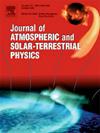Forecasting near-surface air temperature via SARIMA and LSTM: A regional time-series study
IF 1.9
4区 地球科学
Q3 GEOCHEMISTRY & GEOPHYSICS
Journal of Atmospheric and Solar-Terrestrial Physics
Pub Date : 2025-08-19
DOI:10.1016/j.jastp.2025.106604
引用次数: 0
Abstract
Accurate modeling of near-surface air temperature (AT) trends is critical for assessing global and regional climate risks, particularly in light of the intensifying warming signals observed across the northern hemisphere and the tropics. This study proposes a robust and computationally efficient framework for forecasting near-surface AT across the global, the northern hemisphere, the southern hemisphere, and the tropics using two complementary time-series modeling techniques: seasonal autoregressive integrated moving average (SARIMA) and long short-term memory (LSTM) networks. The models are trained to capture both structured seasonal patterns and nonlinear temporal dynamics by leveraging the ERA5 reanalysis dataset (1970–2024) and incorporating preprocessing steps such as detrending and Z-score normalization. SARIMA consistently outperformed LSTM across most domains, particularly in the global region, achieving lower RMSE (0.0967 °C) and higher correlation (R = 0.9975), reflecting its superior capacity for linear and seasonal signal extraction. Quantitatively, SARIMA demonstrates 5%–10% lower RMSE and slightly higher correlation than LSTM across all domains, underscoring the statistical significance of its performance advantage. Projected near-surface AT anomalies by 2050 reveal a marked warming trend, with the SARIMA model estimating a global anomaly of +1.078 °C and a northern hemisphere anomaly of +1.474 °C, closely aligning with IPCC-reported trajectories and exceeding CMIP5 RCP4.5 projections. The findings underscore SARIMA’s reliability for short- to mid-term near-surface AT forecasting and LSTM’s potential for future hybrid modeling schemes. This work fills a critical methodological gap by integrating statistical rigor with scalable deep learning, offering enhanced fidelity for regional climate adaptation planning.
利用SARIMA和LSTM预测近地表气温:区域时间序列研究
近地表气温(AT)趋势的准确建模对于评估全球和区域气候风险至关重要,特别是考虑到北半球和热带地区观测到的变暖信号不断增强。本研究提出了一个强大且计算效率高的框架,用于预测全球、北半球、南半球和热带的近地面AT,使用两种互补的时间序列建模技术:季节自回归综合移动平均(SARIMA)和长短期记忆(LSTM)网络。通过利用ERA5再分析数据集(1970-2024),并结合去趋势和z得分归一化等预处理步骤,对模型进行训练,以捕获结构化的季节模式和非线性时间动态。SARIMA在大多数领域,特别是在全球区域,始终优于LSTM,实现了更低的RMSE(0.0967°C)和更高的相关性(R = 0.9975),反映了其在线性和季节性信号提取方面的卓越能力。在数量上,SARIMA在所有领域的RMSE都比LSTM低5%-10%,相关性略高,强调了其性能优势的统计显著性。预估的2050年近地表AT异常显示出明显的变暖趋势,SARIMA模式估计全球异常为+1.078°C,北半球异常为+1.474°C,与ipcc报告的轨迹密切一致,超过了CMIP5 RCP4.5的预估。研究结果强调了SARIMA在中短期近地面AT预报中的可靠性,以及LSTM在未来混合建模方案中的潜力。这项工作通过将统计严谨性与可扩展的深度学习相结合,填补了一个关键的方法空白,为区域气候适应规划提供了更高的保真度。
本文章由计算机程序翻译,如有差异,请以英文原文为准。
求助全文
约1分钟内获得全文
求助全文
来源期刊

Journal of Atmospheric and Solar-Terrestrial Physics
地学-地球化学与地球物理
CiteScore
4.10
自引率
5.30%
发文量
95
审稿时长
6 months
期刊介绍:
The Journal of Atmospheric and Solar-Terrestrial Physics (JASTP) is an international journal concerned with the inter-disciplinary science of the Earth''s atmospheric and space environment, especially the highly varied and highly variable physical phenomena that occur in this natural laboratory and the processes that couple them.
The journal covers the physical processes operating in the troposphere, stratosphere, mesosphere, thermosphere, ionosphere, magnetosphere, the Sun, interplanetary medium, and heliosphere. Phenomena occurring in other "spheres", solar influences on climate, and supporting laboratory measurements are also considered. The journal deals especially with the coupling between the different regions.
Solar flares, coronal mass ejections, and other energetic events on the Sun create interesting and important perturbations in the near-Earth space environment. The physics of such "space weather" is central to the Journal of Atmospheric and Solar-Terrestrial Physics and the journal welcomes papers that lead in the direction of a predictive understanding of the coupled system. Regarding the upper atmosphere, the subjects of aeronomy, geomagnetism and geoelectricity, auroral phenomena, radio wave propagation, and plasma instabilities, are examples within the broad field of solar-terrestrial physics which emphasise the energy exchange between the solar wind, the magnetospheric and ionospheric plasmas, and the neutral gas. In the lower atmosphere, topics covered range from mesoscale to global scale dynamics, to atmospheric electricity, lightning and its effects, and to anthropogenic changes.
 求助内容:
求助内容: 应助结果提醒方式:
应助结果提醒方式:


